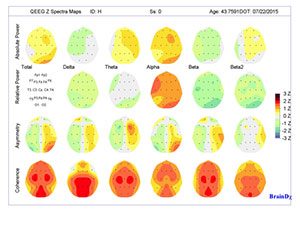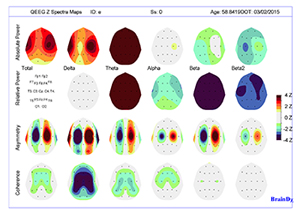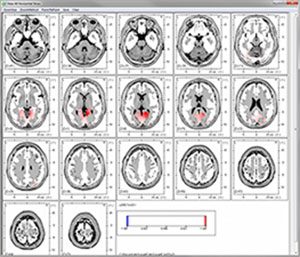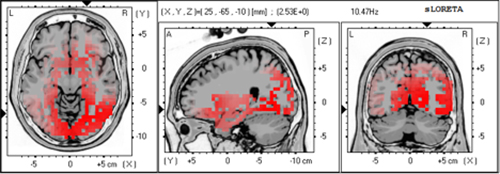Treatment Options
Your brain creates simple electricity through an electrochemical process, which allows it to carry out all of it’s functions, including learning, communicating and managing emotions. Brain mapping is a method of recording this electrical activity in the form of brainwaves and analyzing the results. Brainwaves occur at different frequencies depending on what your brain is doing. For example, when your brain is under-aroused, as occurs when you are sleeping or daydreaming, your brainwaves will be slower. When you are alert and focused, your brainwaves will be much faster as your brain works to fully process the information it receives. It is important for faster brainwaves to be active for controlling attention, emotions, learning and behavior. If your brain is producing too many slow brainwaves (called Alpha, Delta or Theta waves) or too few fast brainwaves (called Beta or Gamma waves), then it is functioning at reduced capacity ideal for learning and performing. [inline:MapsLarge.jpg=Sample Brain Map]To capture and measure brainwave activity, Southwest Neurofeedback uses Quantitative Electroencephalography – also called qEEG Brain Mapping. The information captured in this process is displayed as color-coded maps showing brainwave activity in different parts of the brain. To learn more about the different types of waves and how they are measured, read our brief explanation on how brainwaves are measured.
How are qEEG Brainmaps used?
 The most important use of the qEEG is to provide a guide for improving abnormal brain functioning using Neurofeedback training. The patterns created by measuring your brainwaves are compared to databases of brain map recordings from healthy individuals of the same age, generating thousands of statistical reference points. Any differences are displayed as Z-Scores, or standard deviations, representing how much your brain map differs from the sample population in a given region of the brain.
The most important use of the qEEG is to provide a guide for improving abnormal brain functioning using Neurofeedback training. The patterns created by measuring your brainwaves are compared to databases of brain map recordings from healthy individuals of the same age, generating thousands of statistical reference points. Any differences are displayed as Z-Scores, or standard deviations, representing how much your brain map differs from the sample population in a given region of the brain.
Using the Z scores and information obtained from the color-coded maps, the Center for Attention Deficit and Learning Disorders can determine a course of treatment for improvement in areas such as learning, behavior and performance by re-training brainwave activity.
What is the process for doing a qEEG Brain Map?
Recording a brain map is a simple, non-invasive process using 19 special sensors placed on the head using the International 10-20 system. This universal protocol positions each sensor on a precise part of the brain. Once recording starts, you will sit comfortably for a short period while the qEEG recording is complete. Analysis of the results is completed at our center and reviewed by Dr. Silverman. Based on the results, a treatment plan is initiated along with an explanation of the findings what to expect from treatment.
Enhanced Mapping Using LORETA Analysis

 LORETA Brain Mapping — also called Low Resolution Brain Electromagnetic Tomography (LORETA), is a method of producing three-dimensional patterns of activity in your brain. Each image highlights activity in different regions of the brain at different frequencies. The advantage of LORETA testing over using only standard qEEG is the ability to find functional abnormalities in the deeper structures of the brain, similar to a functional magnetic resonance (fMRI) but at much lower cost.
LORETA Brain Mapping — also called Low Resolution Brain Electromagnetic Tomography (LORETA), is a method of producing three-dimensional patterns of activity in your brain. Each image highlights activity in different regions of the brain at different frequencies. The advantage of LORETA testing over using only standard qEEG is the ability to find functional abnormalities in the deeper structures of the brain, similar to a functional magnetic resonance (fMRI) but at much lower cost.

We often use LORETA in circumstances where enhanced images are needed to help diagnose a condition. For more information and to learn how qEEG brainmapping can help you, please contact us or call 480-314-4299.
